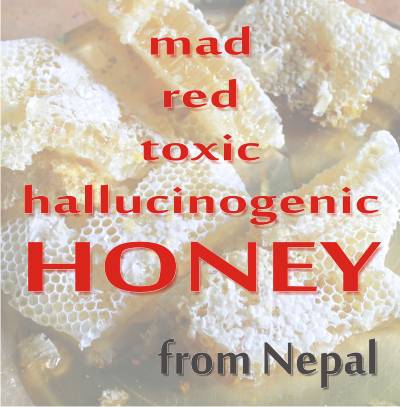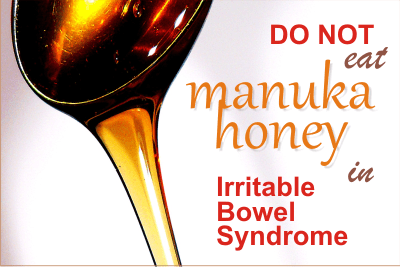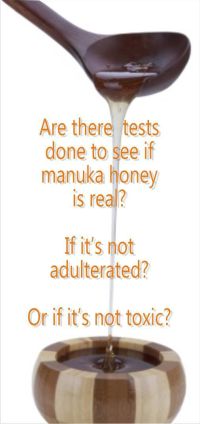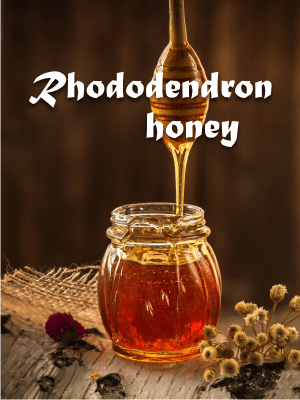No, I’m not kidding. There is a type of honey called ‘mad honey”, and yes, it may have hallucinogenic effects!
I mean, where do all the drugs originate from? Herbs! What is honey made of? Pollen of the herbs! So, if the bees arrive in an area of some psychedelic plants, the honey will have the plants’ “qualities”.
Where can we find hallucinogenic honey?
The story of “mad honey” starts in Turkey. And Nepal.
In Turkey, mad honey is a dark, reddish honey, known as deli bal. It contains an ingredient from rhododendron nectar called grayanotoxin, which is a natural neurotoxin. In small quantities, it brings on light-headedness and sometimes, hallucinations.

In the 1700s, the Black Sea region traded this potent product with Europe, where the honey was infused with drinks to give boozers a greater high than alcohol could deliver. Wow!
![]() When over-imbibed, however, the honey can cause low blood pressure and irregularities in the heartbeat that bring on nausea, numbness, blurred vision, fainting, potent hallucinations, seizures, and even death, in rare cases.
When over-imbibed, however, the honey can cause low blood pressure and irregularities in the heartbeat that bring on nausea, numbness, blurred vision, fainting, potent hallucinations, seizures, and even death, in rare cases.
Nowadays, cases of mad honey poisoning crop up every few years—oftentimes in travelers who have visited Turkey.

There are rhododendrons everywhere, why is this hallucinogenic honey only in Turkey?
They are not only in Turkey. But the most famous ones are the Mad Honey from Nepal and the Mad honey from Turkey (Deli bal), which is most common in the region fringing the Black Sea — the biggest honey-producing region in Turkey. It is produced from rhododendrons, and these plants grow in vast areas, all over the world!
Though, there are more than 700 different species of rhododendron in the world, only two or three include grayanotoxin in their nectars. (says Dr. Süleyman Turedi, who studies deli bal’s effects, doctor at the Karadeniz Technical University School of Medicine in Trabzon, Turkey.): Rhododrendron ponticum and Rhododendron luteum.
The mountains around the Black Sea provide the perfect habitat for these flowers to grow in monocrop-like swaths. Bees arrive in these fields, where there are no other flowers, so no other nectar gets mixed in. It results a pure, potent honey.
Why are the Turks producing hallucinogenic honey?
Because they are using it as medicine. 🙂
It treats hypertension, diabetes mellitus and some different stomach diseases. And, some people use deli bal to improve their sexual performance.
Read more about all health benefits of mad honey from Turkey.
The honey is taken in small amounts, sometimes boiled in milk, and consumed just before breakfast. This means it is considered medicine and should be taken likewise, not on toast or with tea.
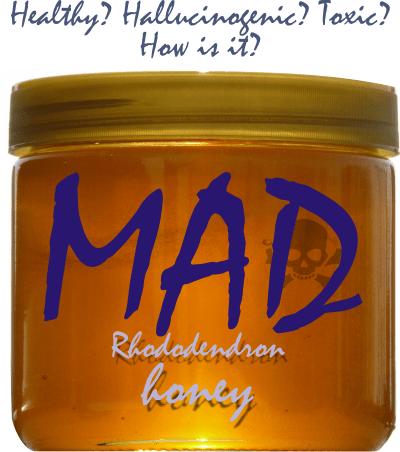 read more on the characteristics of mad honey from Turkey
read more on the characteristics of mad honey from Turkey
Is this hallucinogenic mad honey legal?
It is legal in Turkey. And we can also find it over the internet. Yet, though it is like $166 per pound, we cannot be sure it’s the real thing. The beekeepers who produce it, only sell it in a closed circle, only to those who know how to use it properly. Never to foreigners.
Is there a danger if we eat too much mad honey?
If anybody eats more than 1 spoonful of honey including grayanotoxin, is at risk of mad honey poisoning! And if we refer to fresh honey, then we should eat even less than 1 teaspoon.

Science facts:
“Many plants of the Ericaceae family, Rhododendron, Pieris, Agarista and Kalmia, contain diterpene grayanotoxins. Consuming the honey made from these plants may result in intoxication, specifically characterized by dizziness, hypotension and atrial-ventricular block.
Symptoms are caused by an inability to inactivate neural sodium ion channels resulting in continuous increased vagal tone.
Grayanotoxin containing products are currently sold online, which may pose an increasing risk. In humans, intoxication is rarely lethal, in contrast to cattle and pet poisoning cases.
Scientific evidence for the medicinal properties of grayanotoxin containing preparations, such as honey or herbal preparations in folk medicine, is scarce, and such use may even be harmful.” (according to www.ncbi.nlm.nih.gov)
Other related posts:
• Toxic honey – a list of 4 toxic honeys
• Viper’s Bugloss honey (Echium vulgare honey) – honey considered hepatotoxic if consumed in large quantities.
• A new dispute on manuka honey market: Is it toxic or not?
• How is manuka honey tested? Can we trust those tests?
***************************
References:
http://modernfarmer.com/2014/09/strange-history-hallucinogenic-mad-honey/;
http://www.ncbi.nlm.nih.gov/pmc/articles/PMC3404272/
Picture sources:
• “Garden with Rhododendrons” by TriviaKing at en.wikipedia – Own work (Original caption: “I created this image entirely by myself.”)Transferred from en.wikipedia by Ronhjones. Licensed under Creative Commons Attribution-Share Alike 3.0 via Wikimedia Commons;
• “Rhododendron ferrugineum” (“Alpenroos”) crop picture by albert kok – Own work. Licensed under Creative Commons Attribution 3.0 via Wikimedia Commons;
• Rhododendron from Japan “Rhododendron&Vast ocean of clouds、コバノミツバツツジ&篠山盆地雲海、盃ヶ岳4256293” by 松岡明芳 – 松岡明芳. Licensed under Creative Commons Attribution-Share Alike 3.0 via Wikimedia Commons;
• “Rhododendron wardii var puralbum”. Licensed under Creative Commons Attribution-ShareAlike 2.5 via Wikipedia

